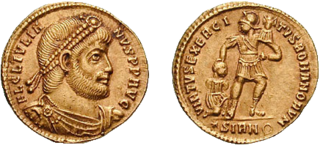
Hoplites(HOP-lites) were citizen-soldiers of Ancient Greek city-states who were primarily armed with spears and shields. Hoplite soldiers utilized the phalanx formation in order to be effective in war with fewer soldiers. The formation discouraged the soldiers from acting alone, for this would compromise the formation and minimize its strengths. The hoplites were primarily represented by free citizens—propertied farmers and artisans—who were able to afford the bronze armour suit and weapons. Hoplites were not professional soldiers and often lacked sufficient military training. However, some states did maintain a small elite professional unit, known as the epilektoi ("chosen") since they were picked from the regular citizen infantry. These existed at times in Athens, Argos, Thebes (Greece), and Syracuse, among others. Hoplite soldiers were relied on heavily and made up the bulk of ancient Greek armies of the time.
A Roman legion(romanum legio) was a large unit of the Roman army.
Maniple was a tactical unit of the Roman legion adopted during the Samnite Wars. It was also the name of the military insignia carried by such unit.
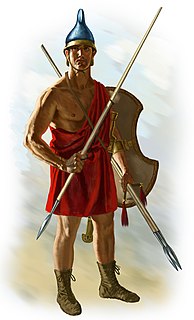
A peltast was a type of light infantry, originating in Thrace and Paeonia, who often served as skirmishers in Hellenic and Hellenistic armies. In the Medieval period the same term was used for a type of Byzantine infantryman.

The phalanx was a rectangular mass military formation, usually composed entirely of heavy infantry armed with spears, pikes, sarissas, or similar pole weapons. The term is particularly used to describe the use of this formation in Ancient Greek warfare, although the ancient Greek writers used it to also describe any massed infantry formation, regardless of its equipment. Arrian uses the term in his Array against the Alans when he refers to his legions. In Greek texts, the phalanx may be deployed for battle, on the march, or even camped, thus describing the mass of infantry or cavalry that would deploy in line during battle. They marched forward as one entity.
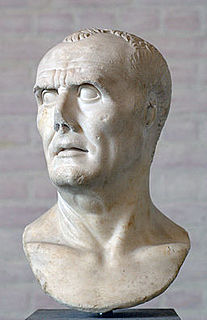
The Marian reforms of 107 BC were a group of military reforms initiated by Gaius Marius, a statesman and general of the Roman Republic.

The formation of a shield wall is a military tactic that was common in many cultures in the Pre-Early Modern warfare age. There were many slight variations of this tactic among these cultures, but in general, a shield wall was a "wall of shields" formed by soldiers standing in formation shoulder to shoulder, holding their shields so that they abut or overlap. Each soldier benefits from the protection of his neighbours' shields as well as his own.
Hasta is a Latin word meaning "spear". Hastae were carried by early Roman legionaries, in particular they were carried by and gave their name to those Roman soldiers known as hastati. However, during republican times, the hastati were re-armed with pila and gladii and the hasta was only retained by the triarii.
As the Roman kingdom successfully overcame opposition from the Italic hill tribes, and became a larger state, the age of tyranny in the easteiiMediterranean began to subside. Inspired by the idea of new constitutions arising there, the Roman populace threw off the yoke of tyranny and established a republic. The army was now facing threats from all of Europe and could only respond through change. This article covers the military establishment of the Roman Republic. For previous changes in the Roman army, see military establishment of the Roman kingdom.
The term Accensi is applied to two different groups. Originally, the accensi were light infantry in the armies of the early Roman Republic. They were the poorest men in the legion, and could not afford much equipment. They did not wear armour or carry shields, and their usual position was part of the third battle line. They fought in a loose formation, supporting the heavier troops. They were eventually phased out by the time of Second Punic War. In the later Roman Republic the term was used for civil servants who assisted the elected magistrates, particularly in the courts, where they acted as ushers and clerks.
The structural history of the Roman military concerns the major transformations in the organization and constitution of ancient Rome's armed forces, "the most effective and long-lived military institution known to history." From its origins around 800 BC to its final dissolution in AD 476 with the demise of the Western Roman Empire, Rome's military organization underwent substantial structural change. At the highest level of structure, the forces were split into the Roman army and the Roman navy, although these two branches were less distinct than in many modern national defense forces. Within the top levels of both army and navy, structural changes occurred as a result of both positive military reform and organic structural evolution. These changes can be divided into four distinct phases.

A javelin is a light spear designed primarily to be thrown, historically as a ranged weapon, but today predominantly for sport. The javelin is almost always thrown by hand, unlike the bow and arrow and slingshot, which shoot projectiles from a mechanism. However, devices do exist to assist the javelin thrower in achieving greater distance, generally called spear-throwers.
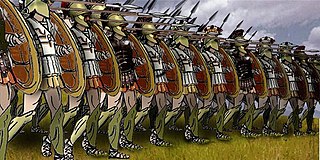
Heavy infantry refers to heavily armed and armoured infantrymen trained to mount frontal assaults and/or anchor the defensive center of a battle line. This differentiates them from light infantry which are relatively mobile and lightly armoured skirmisher troops intended for screening, scouting, and other roles unsuited to the heavier soldiers.
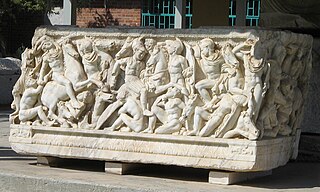
The Hellenistic armies is the term applied to the armies of the successor kingdoms of the Hellenistic period, which emerged after the death of Alexander the Great. After his death, Alexander's huge empire was torn between his successors, the Diadochi. During the Wars of the Diadochi, the Macedonian army, as developed by Alexander and Philip II, gradually adopted new units and tactics, further developing Macedonian warfare and improving on the tactics used in the Classical era. The armies of the Diadochi bear few differences from that of Alexander, but during the era of the Epigonoi, the differences were obvious, favoring numbers over quality and weight over maneuverability. The limited availability of Greek conscripts in the east led to an increasing dependence on mercenary forces, whereas in the west, Hellenistic armies were continuously involved in wars, which soon exhausted local manpower, paving the way for Roman supremacy. The major Hellenistic states were the Seleucid Empire, Ptolemaic Egypt and the Antigonid kingdom (Macedonia). Smaller states included: Attalid Pergamum, Pontus, Epirus, the Achaean League, the Aetolian League, Syracuse, and other states.
Velites were a class of infantry in the Roman army of the mid-Republic from 211 to 107 BC. Velites were light infantry and skirmishers who were armed with a number of darts, each with a 30-inch wooden shaft the diameter of a finger, with a c. 10-inch narrow metal point, to fling at the enemy. They also carried short thrusting swords, or gladii, for use in melee. They rarely wore armour as they were the youngest and poorest soldiers in the legion and could not afford much equipment. They did carry small wooden shields called parma for protection, and wore headdresses made from wolf skins so their brave deeds could be recognized. The velites were placed at the front partly for tactical reasons, and also so that they had the opportunity to secure glory for themselves in single combat.
Principes were spearmen, and later swordsmen, in the armies of the early Roman Republic. They were men in the prime of their lives who were fairly wealthy, and could afford decent equipment. They were the heavier infantry of the legion who carried large shields and wore good quality armor.

Triarii were one of the elements of the early Roman military manipular legions of the early Roman Republic. They were the oldest and among the wealthiest men in the army and could afford high quality equipment. They wore heavy metal armor and carried large shields, their usual position being the third battle line. They were equipped with spears and were considered to be elite soldiers among the legion.
Leves were javelin-armed skirmishers in the army of the early Roman Republic. They were typically some of the youngest and poorest men in the legion, and could not afford much equipment. They were usually outfitted with just a number of light javelins and no other equipment. There were 300 leves in a legion, and unlike other infantry types they did not form their own units, but were assigned to units of hastati — heavier sword-armed troops. Their primary purpose on the battlefield was to harass the enemy with javelin fire and support the heavy infantry who fought in hand-to-hand combat. Accensi and rorarii were also light missile troops and had similar roles.


